Navigate the symbolic tempests of the Bible to uncover ancient wisdom for life's storms, revealing more than just tales of divine intervention.

Meaning of Storm in the Bible
Did you know that storms are mentioned over a hundred times across the Old and New Testaments?
You'll find that these tempests aren't just random acts of nature; they're laden with deep symbolism and messages, often serving as pivotal moments for divine intervention, personal trials, or reflections of chaos and order.
Whether it's Jesus calming the sea or Jonah's tumultuous journey, these narratives invite you to explore the layers of meaning behind the biblical storms.
As you consider their significance, you might uncover insights into navigating life's own tumultuous challenges, making this ancient wisdom surprisingly relevant today.
Key Takeaways
- Storms in the Bible symbolize divine intervention, power, and messages of change or repentance.
- They serve as metaphors for human emotions, spiritual states, and the interplay between chaos and order.
- Biblical storms prompt self-reflection, faith strengthening, and alignment with God's will through challenges.
- Narratives featuring storms highlight the importance of trust in God, endurance, and personal growth in faith.
Symbolism of Storms
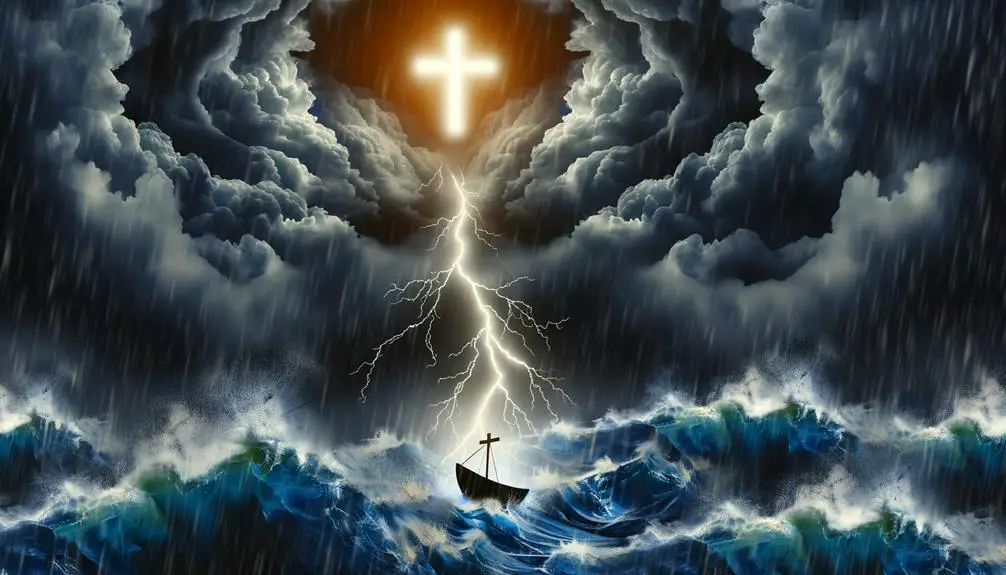
In biblical texts, storms often symbolize divine intervention or the manifestation of God's power, challenging us to reflect on our own vulnerabilities and the majesty of the divine. These narratives don't merely recount physical events but delve deeply into the realm of emotional metaphors, where nature's fury becomes a mirror for human emotions and spiritual states. When you encounter these stories, you're invited into a contemplative space where the external turmoil mirrors internal upheavals, offering a poignant commentary on the human condition.
The symbolism of storms extends beyond mere demonstrations of power. They serve as critical junctures in the narrative, where characters and, by extension, readers are faced with the raw essence of faith and the necessity of trust in the face of overwhelming odds. This isn't just about acknowledging the power beyond oneself but also confronting one's limitations and the sometimes terrifying prospect of surrender to forces beyond one's control.
Through the lens of nature's fury, biblical authors weave intricate emotional metaphors that resonate with the universal human experience of facing adversity. Storms in these texts aren't random acts of nature but are imbued with profound spiritual significance. They compel us to examine our lives, question our assumptions, and ultimately, deepen our understanding of the divine. In this reflective process, the storm becomes more than a symbol of divine intervention; it transforms into a catalyst for personal insight and spiritual growth, challenging you to find peace and purpose amidst the chaos.
Storms as Divine Messages

You've seen how storms symbolize various aspects in biblical narratives, but let's shift our focus to their role as divine messages.
Storms often serve as warnings from God, signaling a need for change or repentance among His people.
They also embody His mighty presence, reminding us of His power and proximity in times of turmoil.
Divine Warnings Through Storms
Storms often serve as divine messengers, warning communities and individuals of impending judgment or the need for repentance. When you delve into biblical narratives, you'll find that storm interpretations carry a deep prophetic significance, framing these natural phenomena not merely as meteorological events but as theological symbols. These tempests aren't random; they're imbued with divine intentionality, signaling a moment for reflection and a call to action.
Analyzing these stories, you're invited to consider the storms in your life as possibly more than just physical occurrences. They might be divine prompts, urging you to assess your path and make necessary changes. This perspective transforms how you perceive challenges, seeing them not as mere obstacles but as opportunities for growth and alignment with a higher purpose.
Storms Symbolizing God's Presence
While exploring the biblical narrative, it's evident that storms not only serve as warnings but also symbolize the tangible presence of God, delivering divine messages to humanity. This storm imagery beckons you to consider the multifaceted character of God, who communicates through the awe-inspiring and the formidable.
The storms, with their overwhelming power, invite a fearful reverence, reminding you of the vast difference between the Creator and the created. Such narratives encourage a reflective posture, urging you to discern the divine messages woven through the tempests.
It's in the midst of these storms that you're often drawn closer to understanding God's mysterious ways, recognizing the storms not merely as natural phenomena but as carriers of profound, divine significance.
Chaos and Order

In biblical narratives, storms often symbolize the dynamic interplay between chaos and order, reflecting profound theological and existential themes. You'll notice that storms function as both literal and metaphorical devices, pointing to the fragile cosmic balance that governs existence. This delicate equilibrium is constantly under threat from natural disruptions, which storms vividly depict. Their occurrence in scripture isn't merely for dramatic effect; they serve as rich symbols of life's unpredictability and the divine authority that ultimately restores balance.
Aspect |
Significance |
|---|---|
Cosmic balance |
Demonstrates the harmony of creation, disrupted by storms but restored through divine intervention. |
Natural disruptions |
Highlight the vulnerability of human life and societies to the forces of nature, underscoring the need for divine guidance and protection. |
Through this lens, storms are not just chaotic elements; they're essential to the narrative's exploration of order. They remind us of humanity's place within the larger cosmic scheme, susceptible to forces beyond our control, yet under the watchful eye of a higher power that seeks to restore order from chaos. This duality invites reflection on the nature of existence itself, posing questions about human resilience in the face of natural upheavals and the role of faith in navigating these challenges.
In essence, storms encapsulate the ongoing struggle between chaos and order, mirroring the human journey through life's tumultuous seas towards a hoped-for harbor of stability and peace, guided by divine wisdom.
Personal Trials and Faith

Biblical narratives often depict personal trials as tempests that test one's faith, compelling individuals to seek solace and strength in their spiritual beliefs. You might find yourself in the midst of such storms, where your resilience is put to the test. Indeed, these trials aren't just obstacles; they're opportunities for trial endurance and faith growth. The Bible illustrates how storms aren't merely to be endured but understood as pivotal moments for deepening one's trust in God.
Consider the journey of faith as navigating through a tempestuous sea. You're the vessel, and your faith is the sail. Without the wind of trials, the sail of faith remains limp, unused. It's the gales of adversity that fill your sail, propelling you towards spiritual maturity. In this light, personal trials aren't merely hardships but instruments of divine purpose, sculpting your character and strengthening your faith.
The process of enduring trials and cultivating faith isn't passive. It requires active engagement with your beliefs, constant prayer, and reflection on the Scriptures. This engagement transforms your understanding of trials from mere suffering to meaningful experiences that contribute to your faith growth. As you navigate through these storms, remember, it's not the absence of trials that signifies spiritual strength, but the presence of unyielding faith amidst them.
In the grand tapestry of your spiritual journey, each trial is a thread that contributes to the growth of a resilient, faith-filled character. Embrace these moments, for they're your opportunities to witness the profound depth of faith growth, borne out of trial endurance.
Historical Biblical Storms
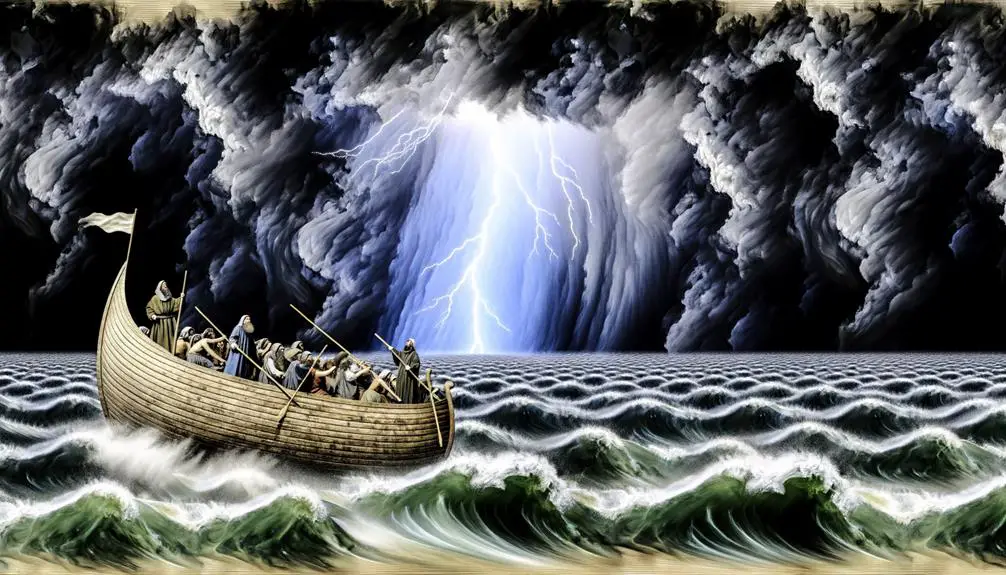
Reflecting on personal trials as tempests that test faith leads us to explore actual storms recounted in the Bible, which serve as profound metaphors for divine intervention and human endurance. These historical biblical storms aren't only epic narratives but also carry deeper meanings, intertwined with the geographical locations and archaeological evidence that lend credence to their historical authenticity.
The Bible, rich in its historical context, introduces us to several significant storms, each with its unique lessons:
- The Great Flood: This cataclysmic event, transcending mere meteorological phenomena, symbolizes divine judgment and the possibility of redemption, grounded in the geographical reality of the ancient Near East.
- Jonah's Storm at Sea: A storm that serves as a divine intervention to redirect Jonah's path, highlighting the unavoidable nature of divine missions. Archaeological evidence from ancient maritime practices enriches our understanding of this narrative.
- The Plagues of Egypt: Among these, hailstorms wreak havoc, demonstrating God's power over nature and the socio-political landscape of Egypt, with archaeological findings supporting the plagues' impacts on the region's history.
These stories, beyond their immediate dramatic impact, invite you to delve into the layers of meaning behind the biblical text. They prompt reflections on human resilience in the face of divine challenges and the intricate relationship between human history and the natural world. The geographical locations and archaeological evidence tether these narratives to the earth, offering you a tangible connection to these timeless lessons of faith, endurance, and the power of the divine.
Jesus Calms the Seas
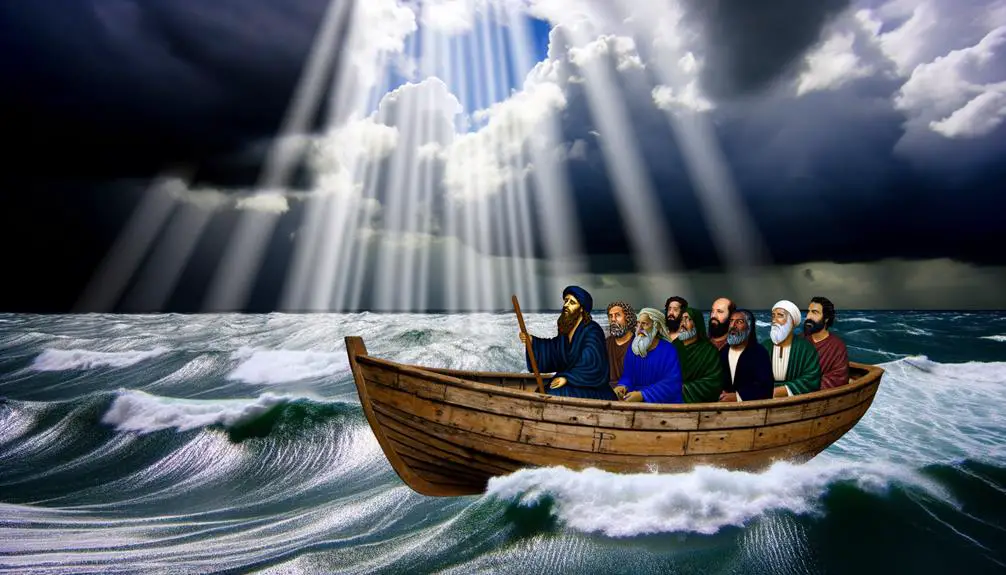
Among the narratives of divine intervention within the Bible, the account of Jesus calming the seas stands as a pivotal moment, showcasing his mastery over nature and inviting you to ponder the depth of your faith amidst life's tumultuous storms. This event, rich in symbolic and literal significance, speaks volumes about miraculous intervention and the Apostles' fear, offering a mirror to your own life's tempests and the potential for peace within them.
Aspect |
Detail |
Reflection |
|---|---|---|
Narrative |
Jesus calms the storm |
Demonstrates divine authority over nature |
Reaction |
Apostles' fear before the calm |
Mirrors human tendency to doubt |
Command |
"Peace, be still" |
Power of faith to restore tranquility |
Outcome |
Immediate calm |
Illustrates miraculous intervention |
Implication |
Faith's role in facing life's storms |
Invites personal reflection on faith |
The Apostles' fear reflects a natural human response to uncontrollable circumstances, highlighting the often-fragile nature of faith when faced with the overwhelming forces of life. Jesus' reaction, a simple yet profoundly effective command, "Peace, be still," underlines the transformative power of faith, capable of silencing the fiercest storms.
This account isn't just a testament to Jesus' divine power; it's a call to introspection. It urges you to examine the strength and depth of your own faith when confronting life's challenges. The miraculous intervention in calming the seas serves as a reminder that, amidst the fiercest storms, faith can be your anchor, offering a peace that transcends understanding.
Lessons From Jonah's Experience
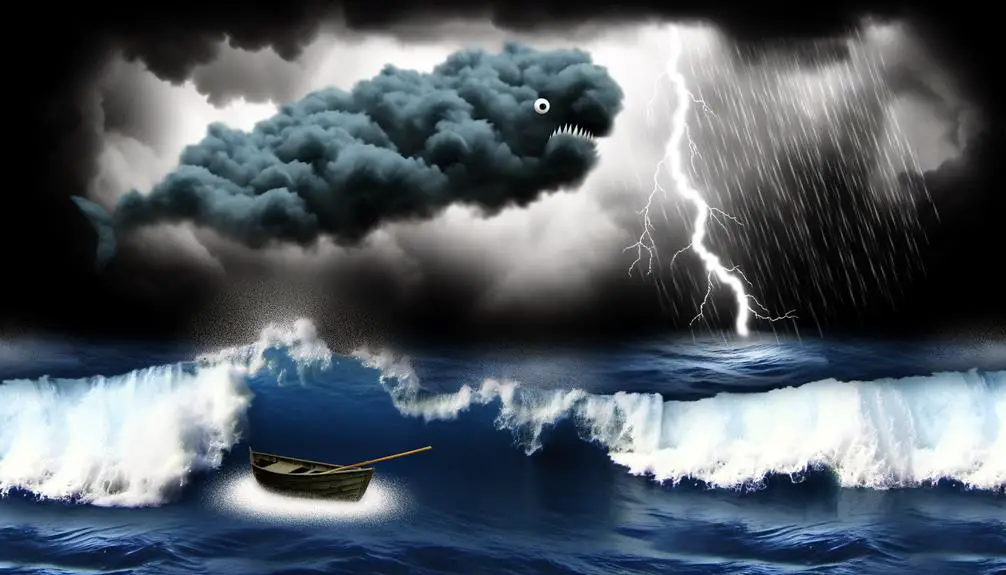
Shifting our focus to Jonah's experience, we encounter another profound biblical narrative that challenges us to consider the consequences of running from our divine calling and the transformative power of repentance and obedience in the midst of life's storms.
Jonah's story isn't merely about a great fish; it's a deeply human account of fear, avoidance, and ultimately, redemption. Through his journey, we're invited to reflect on our own responses to divine assignments that intimidate or inconvenience us.
- Jonah's Regret: Initially, Jonah runs from God's command to preach to Nineveh, leading to his entanglement in a life-threatening storm and his eventual consumption by a great fish. This low point becomes a crucible for transformation, underscoring the profound regret that accompanies disobedience and the isolation from community and purpose it can engender.
- Nineveh's Repentance: The eventual preaching to Nineveh and its inhabitants' collective repentance highlight the wide-reaching impact of individual obedience to divine callings. It's a powerful reminder that our actions, born of faith or fear, ripple out to affect communities and even entire cities.
- Divine Mercy and Second Chances: Jonah's experience with the fish and Nineveh's spared judgment underscore the limitless mercy of God. They invite us to consider how divine compassion isn't just about individual forgiveness but also about restoring relationships and communities.
Jonah's tale teaches us about the dangers of ignoring our divine callings and the redemptive power of facing our fears, embracing repentance, and acting in obedience. It's a narrative that resonates deeply with anyone navigating the storms of life, urging a reflection on the paths we choose and the lives we touch along the way.
Navigating Life's Storms
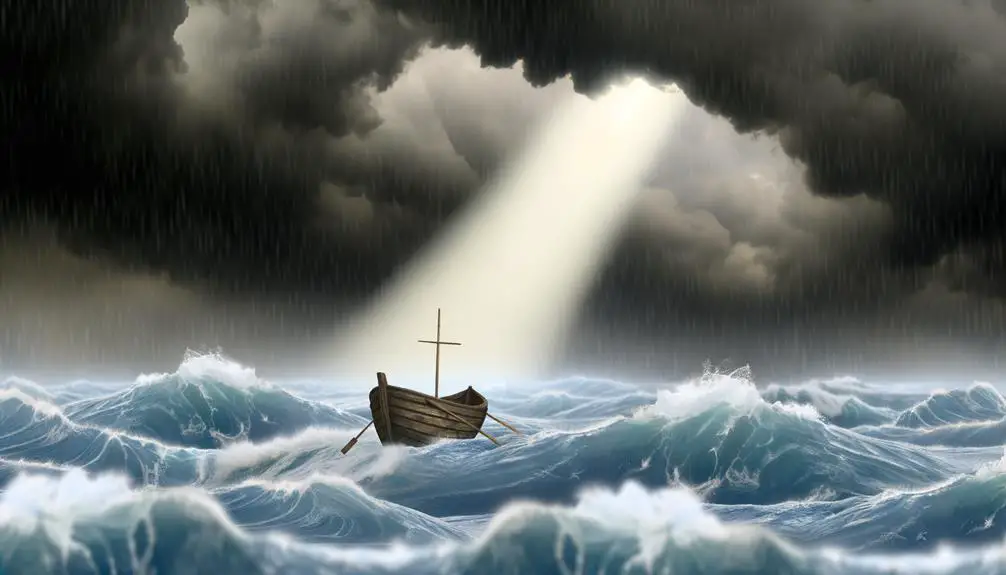
Every individual, at some point in their lives, will navigate the turbulent waters of personal and spiritual storms, a journey that requires both resilience and faith. These tempestuous periods, characterized by trials and tribulations, demand a fortitude that often feels beyond our grasp. However, it's within these tumultuous times that one's true capacity for emotional resilience and spiritual growth is revealed and refined.
Emotional resilience, in this context, isn't merely the ability to bounce back from adversity but to grow from it, to find meaning in the struggle, and to emerge stronger. It's about harnessing your inner strength to confront the storm, rather than avoiding it. This resilience is cultivated through reflective introspection, a practice encouraged in biblical narratives, which often depict storms as catalysts for deep, personal transformation.
Spiritual growth, intertwined with emotional resilience, involves a profound deepening of faith. As you navigate life's storms, you're pushed to rely not just on your strength but on a higher power. This reliance isn't a sign of weakness but an acknowledgment of the limitations of human capacity and the need for divine intervention. It's in the midst of storms that faith becomes more than a concept—it becomes a lifeline.
Navigating life's storms, therefore, is a journey of becoming. It's about learning to weather the tempests with grace, understanding that each storm has a purpose in your spiritual journey. It's about recognizing that, though the waters may be rough, they're also a medium through which emotional resilience is bolstered and spiritual growth is fostered.
Frequently Asked Questions
How Do Different Translations of the Bible Handle the Description of Storms, and Does This Affect Their Symbolic Interpretation?
Different Bible translations handle storm descriptions with varying degrees of translation accuracy. This can impact their symbolic consistency. As you explore these texts, you'll notice that while some translations may offer a more literal interpretation, others might adopt a figurative approach, affecting the symbolic interpretation of storms.
This variation requires a reflective analysis to understand how each translation influences the perceived message and symbolism behind storm narratives.
Are There Any Lesser-Known Biblical Stories or Texts Outside of the Canonical Bible That Also Use Storms as a Metaphor, and What Do They Signify?
You might find it intriguing that over 20 apocryphal texts use storm symbolism. These lesser-known stories, outside the canonical Bible, dive deep into storm metaphors.
In apocryphal narratives, storms often symbolize divine intervention or a test of faith, reflecting a complex relationship between humans and the divine.
Analyzing these texts offers a richer understanding of storm symbolism, revealing layers of meaning beyond traditional interpretations.
How Have Different Cultures and Religions That Are Familiar With the Bible Interpreted Storms and Their Meanings Differently?
You'll find that storm symbolism varies widely across cultures familiar with the Bible. Each interprets the tumult and calm of storms through a unique lens.
For some, storms symbolize divine wrath or cleansing, while others see them as metaphors for personal or communal transformation.
This diversity in cultural perceptions reflects deep, reflective analysis of human and divine nature, showcasing a rich tapestry of beliefs surrounding the power and meaning of storms.
In What Ways Have Modern Theologians Critiqued or Expanded Upon Traditional Interpretations of Biblical Storms?
You're navigating the vast ocean of biblical interpretation, where modern theologians have stirred the waters with their critiques and expansions on traditional views of storms.
Through theological reinterpretations, they've introduced modern metaphors, likening storms to personal and societal challenges. This reflective, scholarly analysis has enriched our understanding, showing that biblical storms aren't just historical or natural events but deep, multifaceted symbols that resonate with today's spiritual and ethical dilemmas.
Can the Concept of Storms in the Bible Be Linked to Environmental Stewardship or Ecological Concerns From a Contemporary Perspective?
Absolutely, you can link storms to environmental stewardship and ecological concerns today. By analyzing these biblical events, you're reflecting on humanity's role in climate advocacy.
It prompts a deeper consideration of how our advancements and technological impacts contribute to environmental challenges. This perspective encourages a reevaluation of our stewardship responsibilities, urging a more conscientious approach to preserving our planet.
It's a call to action, rooted in ancient wisdom yet profoundly relevant in today's ecological discussions.
Conclusion
In navigating the tempestuous seas of life, you're not merely dodging raindrops but deciphering divine whispers. Storms, biblically, aren't just meteorological phenomena but metaphysical signposts. They beckon you to find order in chaos, strength in faith amidst fury.
Like Jesus calming the seas or Jonah's transformative ordeal, your trials sculpt resilience, urging you to listen, learn, and lean into faith. Thus, life's storms, with their tumult and turmoil, aren't just to be weathered but understood, a divine dialogue echoing across the ages.


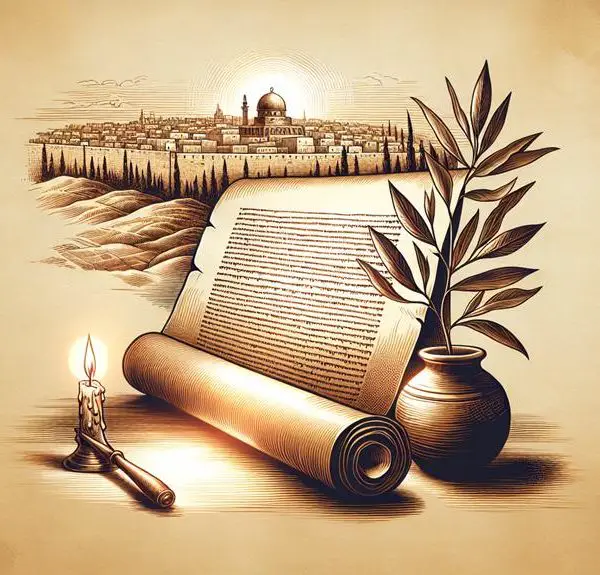
Sign up